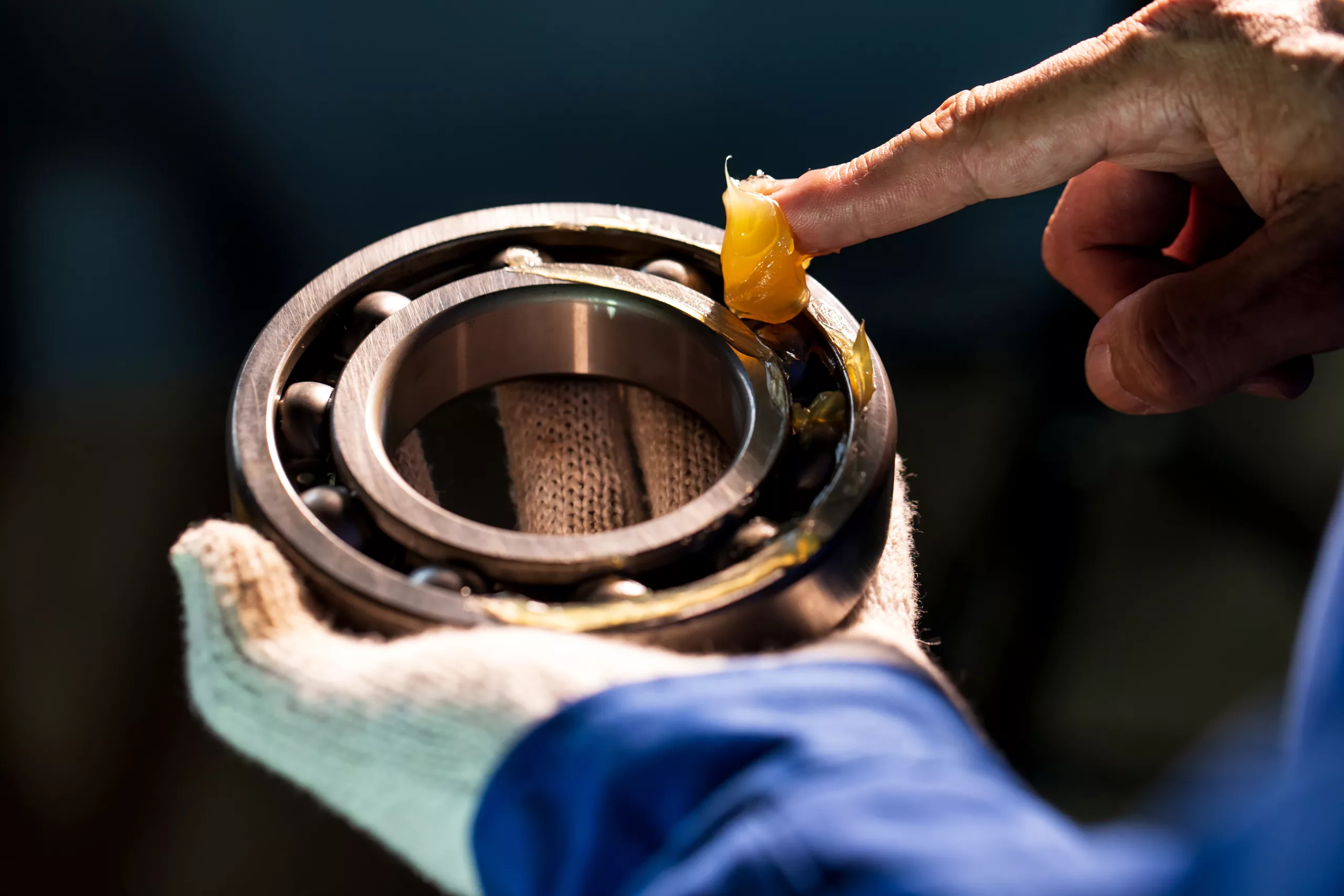Tools and Materials
Before you begin, gather the following tools and materials:
- Grease: Choose a high-quality grease recommended by your motor’s manufacturer, as the type of grease may vary depending on the motor’s design and application.
- Grease Gun: Use an appropriate grease gun with a flexible hose attachment for easier application. If you’re using multiple types of grease, consider using different grease guns.
- Safety Gear: It is a good idea to wear gloves and safety glasses anytime you are working with grease.
- Cleaning Solvent: Obtain a suitable cleaning solvent or degreaser for cleaning the bearing housing and removing old grease.
- Lint-Free Cloth: Use this to wipe away excess grease and dirt.
- Scale: A scale will help you determine the correct amount of lubricant in grams.
Develop a Preventative Maintenance Schedule
Before you proceed with greasing your motor bearings, it’s essential to create an effective preventative maintenance (PM) system. Here are some key factors to consider when setting up a PM system:
- Asset Identification: Assign a unique identifier or asset tag to each motor for easy identification and tracking.
- Installation Date: Record the installation date to schedule maintenance tasks and determine the motor’s age.
- Specifications: Note the motor’s horsepower, frame size, RPM, voltage, and enclosure type to communicate these specifics to the maintenance team.
- Bearing Type: Specify the type of bearings used in each motor, as different bearing types may have distinct maintenance needs.
- Environmental Conditions: Consider the motor’s operating environment, including factors like temperature, humidity, and exposure to dust or corrosive substances, which can impact maintenance requirements.
- Maintenance History: Keeping a detailed record of all maintenance activities, including routine inspections, repairs, and replacements will ensure consistency, regardless of personnel changes.
- Scheduled Maintenance Tasks: Create a schedule for routine preventive maintenance tasks based on the motor’s specifications and operating conditions.
- Failure Analysis: Implement a system for analyzing motor failures and their root causes to identify recurring issues and implement corrective actions.
- Documentation and Training: Ensure that maintenance personnel are trained to use the PM system effectively, and maintain accurate and up-to-date information about your motors and their maintenance needs.
Determine Regrease Schedule
Determining the optimal regrease time cycle for your motor bearings is crucial. Here’s an overview of the factors to consider and the general approach:
- Use Calculators, Tables, and Charts: Various resources, such as calculators, tables, and charts, are available to estimate regrease intervals based on factors like load, operation time, bearing type, temperature, environment, and speed.
- Database Utilization: Maintain a well-organized database with information about bearings, specifications, and historical performance data to track maintenance history and fine-tune regrease intervals over time.
- Trial and Error: Practical experience is essential for fine-tuning regrease intervals. Monitor bearing performance and adjust regrease cycles based on observed wear, lubricant condition, and actual operating conditions.
- Condition Monitoring: Implement condition monitoring techniques such as vibration analysis, temperature monitoring, and oil analysis to assess bearing health and guide regreasing decisions.
- Collaboration: Work closely with maintenance personnel, bearing manufacturers, and lubrication experts to gather insights and recommendations for optimizing regrease intervals.
- Document and Review: Keep detailed records of maintenance activities and outcomes, regularly reviewing them to identify trends and make necessary adjustments to regrease cycles.
Safety Considerations: Ensure that regreasing activities are performed safely, adhering to proper procedures, and using appropriate personal protective equipment (PPE).
In summary, while calculators, tables, and charts provide initial guidelines for establishing regrease time cycles, real optimization comes from data-driven analysis, practical experience, and continuous monitoring. Regularly review and adjust regrease intervals based on specific conditions and bearing performance to maximize equipment reliability and minimize maintenance costs.
Steps to Grease Your Electric Motor Bearings
- Safety First: Disconnect the motor from the power source to prioritize safety during maintenance.
- Check Grease: Ensure that the grease gun contains the appropriate lubricant recommended by the manufacturer. For the majority of the motors we sell we use PolyrexEM from Mobil 1. This is available through us or Bluewater Group.
- Access the Bearings: Locate the bearing housing on your electric motor. Depending on the motor’s design, you may need to remove a cover or access panel to reach the bearings.
- Clean the Bearings: Use the cleaning solvent and a lint-free cloth to thoroughly clean the bearing housing, removing any old grease and contaminants. Ensure the area is completely clean before proceeding.
- Determine the Grease Amount: Grease the bearing with a calculated amount of grease. Slowly add grease to minimize excessive pressure buildup in the grease cavity. Here’s how to determine the appropriate grease quantity:
- Determine the Required Grease Volume: Use the formula: G = 0.114 x D x B, where G is the amount of grease in ounces, D is the bearing outside diameter in inches, and B is the bearing width in inches. Read more here.
- Convert Grease Volume to Shots: To convert the calculated grease volume into shots (pumps of the grease gun), you’ll need to calibrate your grease gun.
- Calibration Process: Pump the grease gun onto the scale and note the weight in grams. Divide the weight in grams by the number of strokes used to achieve that weight. This gives you the amount of grease dispensed per stroke.
Note that the average value is approximately 18 shots per ounce for most manual grease guns, but this can vary significantly between different grease guns, so it’s important to calibrate each gun you use.
- Document the Grease Requirements: Record how much grease is required for each motor’s bearings based on the calculated volume. Specify the frequency of lubrication (how often it needs to be done) to ensure consistency in maintenance practices. Maintenance Team Guidance: Share the documented grease quantity and frequency with your maintenance team to ensure precise application and prevent both over-greasing and under-greasing, which can lead to bearing problems.
- Apply Grease: Attach the grease gun to the grease fitting on the bearing housing. Slowly pump grease into the bearing while rotating it by hand. Watch for grease coming out of the relief port. If excessive amounts of grease are pumped into the motor and the used grease is not being purged, there may be hardened grease blocking the relief passage; stop and check for a block before proceeding.
- Check for Proper Distribution: Ensure that the grease is evenly distributed throughout the bearing to provide adequate lubrication to all bearing surfaces.
- Reassemble and Test: Carefully reassemble any covers or access panels that were removed. Reconnect the motor to the power source and test its operation to confirm that it runs smoothly.
Conclusion
Properly greasing your electric motor bearings is a fundamental maintenance task that can significantly extend the lifespan of your motor. By following these steps and using high-quality grease, you can ensure that your motor operates efficiently and reliably.
Regular maintenance like this not only saves you money on repairs but also minimizes downtime and ensures the continued productivity of your equipment. Remember to consult your motor’s manufacturer for specific recommendations and guidelines.

